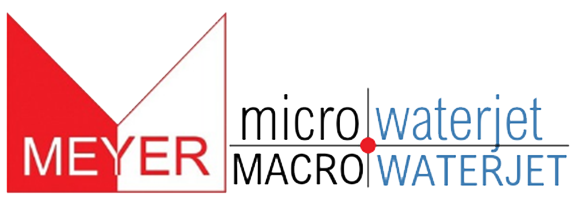If you do not find answers to your questions, please Contact us today!
FAQ
More Than Manufacturing... Complete Answers
Get Your Custom Solution
"*" indicates required fields
Why would I need Microwaterjet® or MACROWATERJET?
In some cases, the parts that we produce cannot be cut any other way due to the combination of features and material type. Our customers are those who would have to post-process their parts after laser cutting or using wire EDM in order to remove slag or a recast layer.
What material size can the Microwaterjet® cutting machine accommodate?
The largest piece of material that we can place on our machine table to cut is 1000mm x 600mm (39”x23.5”).
What material size can the MACROWATERJET cutting machine accommodate?
The largest piece of material that we can place on our machine table to cut is 1700mm x 3700mm (66.9”x145.7”).
What is the thickest material that can be cut using Microwaterjet® cutting technology?
Since our technology was created to produce 2 dimensional parts with fine features and / or high tolerances, many materials processed are less than 3mm (0.125”) thick. However, depending on the material, features and tolerance levels, we are capable of cutting considerably thicker material.
Can Microwaterjet® or MACROWATERJET cut any material?
Almost any material can be cut using our technology. Some types of glass and other extremely brittle materials cannot be cut. Many plastics and ceramics that are challenging to laser technology can be cut by Microwaterjet® and MACROWATERJET.
Does the Microwaterjet® or MACROWATERJET cutting process use an abrasive?
Much like traditional abrasive water jet cutting, we also use an abrasive for almost every cutting job. In rare cases, we can cut using water only if the material is both soft and thin. No metallic materials can be cut without abrasive using our process.
Is Microwaterjet® capable of manufacturing 3-D parts?
Today’s Microwaterjet® equipment is designed strictly for 2-D work, producing parts out of flat material.
Is MACROWATERJET capable of manufacturing 3-D parts?
Our MACROWATERJET system can cut angles up to +/- 60 degrees from flat stock with continuous rotation.
Is Microwaterjet® or MACROWATERJET capable of cutting tubing or round bar material?
Tube and round bar applications are not ideal for a 2-D operation because of the variance in distance between the cutting nozzle and the work piece.
Can Microwaterjet® or MACROWATERJET create channels or etch designs in material?
Abrasive water jet systems are designed to cut clear through substrates. There is no way to control how deep the cut would be if a channel is attempted.
How does Microwaterjet® cutting speed compare to conventional water jet cutting?
Microwaterjet® was developed for creating fine features with higher tolerances than conventional water jet. Since we use a finer cutting stream and finer abrasive, our cutting speed is somewhat slower than conventional speeds.
What is your typical order quantity?
We work closely with engineers who may be in the design phase of a component, requiring, in some cases, a single prototype part. We also have many customers who require production quantities of hundreds or thousands of pieces at a time.
Can I get a free sample of a production part?
We prefer to understand what you are looking for before sending samples that may not have any value to you. Once we decide along with the customer that we may be a good fit, we can arrange for the appropriate sample to be provided.
Should I send an RFQ to you if I am using a local water jet provider?
Please contact us with your existing waterjet project. We will be glad to discuss the quality difference you can expect from us and help you decide if we are a good fit for your needs.
Should I send an RFQ to you if I am using a local wire EDM or laser provider?
Depending on the type of material, feature size, quantities etc., we will want to look at your drawing with you and decide together if it makes sense to move to the quoting step.
If I have a sample part, but no drawing, can you help me?
We utilize an intelligent optical measuring system that can be used in some cases to reverse engineer your part.
To what industries do you provide service?
We are currently provide contract manufacturing to our customers in medical, aviation and aerospace, electronic and electrical, and motor sports.
Is Microwaterjet® precision cutting a more expensive process?
Yes, when compared to conventional water jet cutting or laser cutting, the process is slower resulting in longer cutting time. The cost of your overall project may be marginally or considerably less by using Microwaterjet® if post process operations can be eliminated.
No, when compared to wire EDM cutting. This depends on the features, material thickness and number of penetrations. Microwaterjet® is not a replacement for wire EDM technology.
How long have you been in business?
We have been in operation since 2009 utilizing Microwaterjet® precision cutting equipment serving North America.
How many machines do you have in your North Carolina facility?
Currently we are running four Microwaterjet® machines and one MACROWATERJET machine.
Do you offer the cutting service or sell the equipment?
We provide contract manufacturing services from our North Carolina facility to customers in North America.
Can Microwaterjet® or MACROWATERJET decrease tooling and lead times?
Our process does not require specific (and sometimes expensive) tooling that is typically used in other processes. This allows Microwaterjet® and MACROWATERJET to offer shorter lead times.
How does Microwaterjet® or MACROWATERJET improve the prototyping process?
Both our cutting processes are frequently used for prototype projects as well as low to high volume production.
